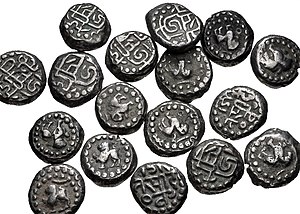Chahamanas of Ranastambhapura
Appearance
Chahamanas of Ranastambhapura | |||||||||
|---|---|---|---|---|---|---|---|---|---|
| 1192 CE–1301 CE | |||||||||
| Capital | Ranastambhapura | ||||||||
| Government | monarchy | ||||||||
| History | |||||||||
• Established | 1192 CE | ||||||||
• Disestablished | 1301 CE | ||||||||
| |||||||||
| Today part of | India | ||||||||

The Chahamanas of Ranastambhapura were a 13th-century Indian dynasty. They ruled the area around their capital Ranastambhapura (Ranthambore) in present-day Rajasthan, initially as vassals of the Delhi Sultanate, and later gained independence. They belonged to the Chahamana (Chauhan) clan of the Rajputs, and are also known as Chauhans of Ranthambore in vernacular Rajasthani bardic literature.
The Chahamana line of Ranastambhapura was established by
Siege of Ranthambore
in 1301.
History
The Chahamana dynasty of Ranastambhapura was established by
Ghurid ruler Muhammad of Ghor appointed Govinda as his vassal at Ajmer. However, Prithviraja's brother Hari-raja de-throned him, and himself became the ruler of Ajmer.[2] Govinda then established a new kingdom with its capital at Ranastambhapura (modern Ranthambor). After the Muslim conquest of Ajmer, he granted asylum to Hari.[1]
Balhana, the son of Govindaraja, is recorded as a vassal of the Delhi Sultan
Iltumish in 1215 CE, but declared independence in the later years.[1] Balhana's elder son Prahlada succeeded him, and died in a lion-hunt. Prahlada's son Viranarayana was invited to Delhi by Iltumish, but was poisoned to death there.[3] Iltumish captured the fort in 1226 CE. Balhana's younger son Vagabhata then ascended the throne. He recaptured Ranthambore during the reign of the Delhi ruler Razia (r. 1236-1240). He successfully defended the fort against the Delhi Sultanate's invasions in 1248 and 1253 CE.[1]
Vagbhata's son
Nasir-ud-din, and ended up paying tribute to the Delhi Sultanate.[1]
Jalal-ud-din and Ala-ud-din's general Ulugh Khan, but was finally killed in a 1301 invasion led by Ala-ud-din Khalji.[1]
List of rulers
List of Chauhan rulers of Ranastambhapura (Ranthambore)
 (1) Govinda-raja (1192)
(1) Govinda-raja (1192) (2) Balhana-deva
(2) Balhana-deva (3) Prahlada-deva
(3) Prahlada-deva (4) Viranarayana
(4) Viranarayana (5) Vagabhata
(5) Vagabhata (6) Jaitra-simha
(6) Jaitra-simha (7) Shakti-deva
(7) Shakti-deva (8) Hammira-deva (1283–1311)
(8) Hammira-deva (1283–1311)
References
- ^ a b c d e f g h Sen 1999, p. 336.
- ^ Narayan 1999, p. 10.
- ^ Sudan 1989, p. 76.
- ^ Sharma 1970, p. 828.
- ^ Sharma 1975, p. 124.
- ^ Majumdar 1966, pp. 85–86.
Bibliography
- Majumdar, Ramesh Chandra (1966). The History and Culture of the Indian People: The struggle for empire. Bharatiya Vidya Bhavan.
- Narayan, Jagat (1999). Ajmer and the Mughal Emperors. Neha Vikas.
- Sen, Shailendra Nath (1999). Ancient Indian History and Civilization. New Age International. ISBN 9788122411980.
- ISBN 978-0-8426-0618-9.
- Sharma, G. N. (1970). Mohammad Habib and Khaliq Ahmad Nizami (ed.). A Comprehensive History of India: The Delhi Sultanat (A.D. 1206-1526). Vol. 5. Indian History Congress / People's.
- Sudan, Anita (1989). A study of the Cahamana inscriptions of Rajasthan. Research Publishers.


